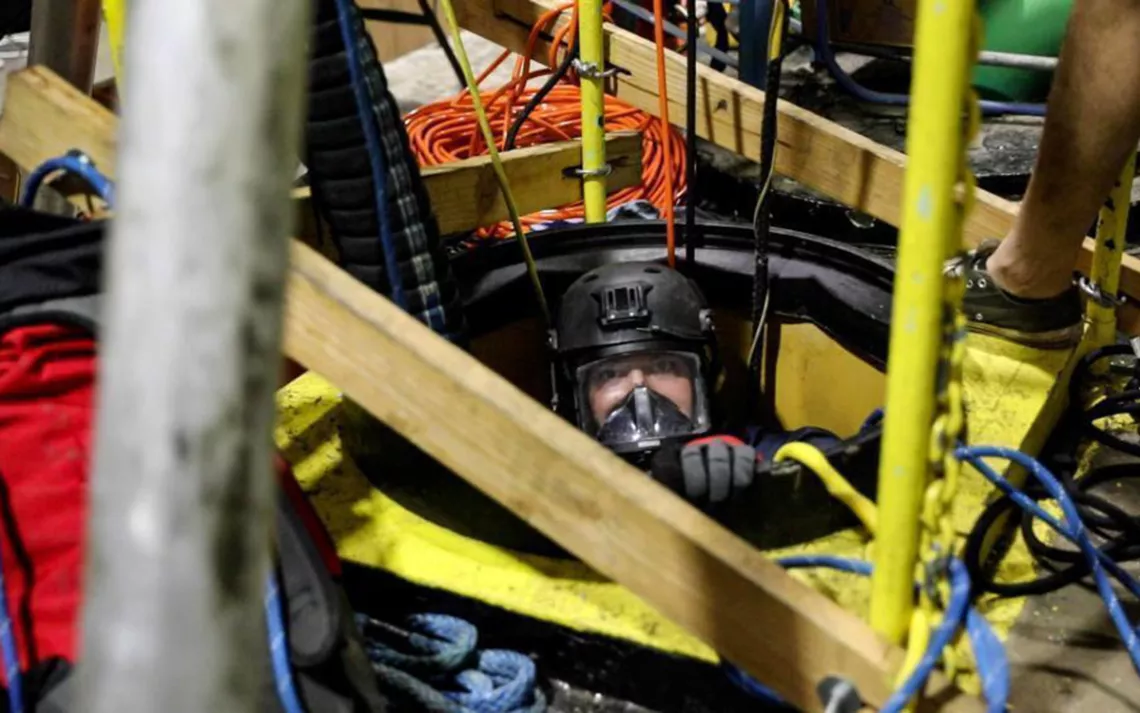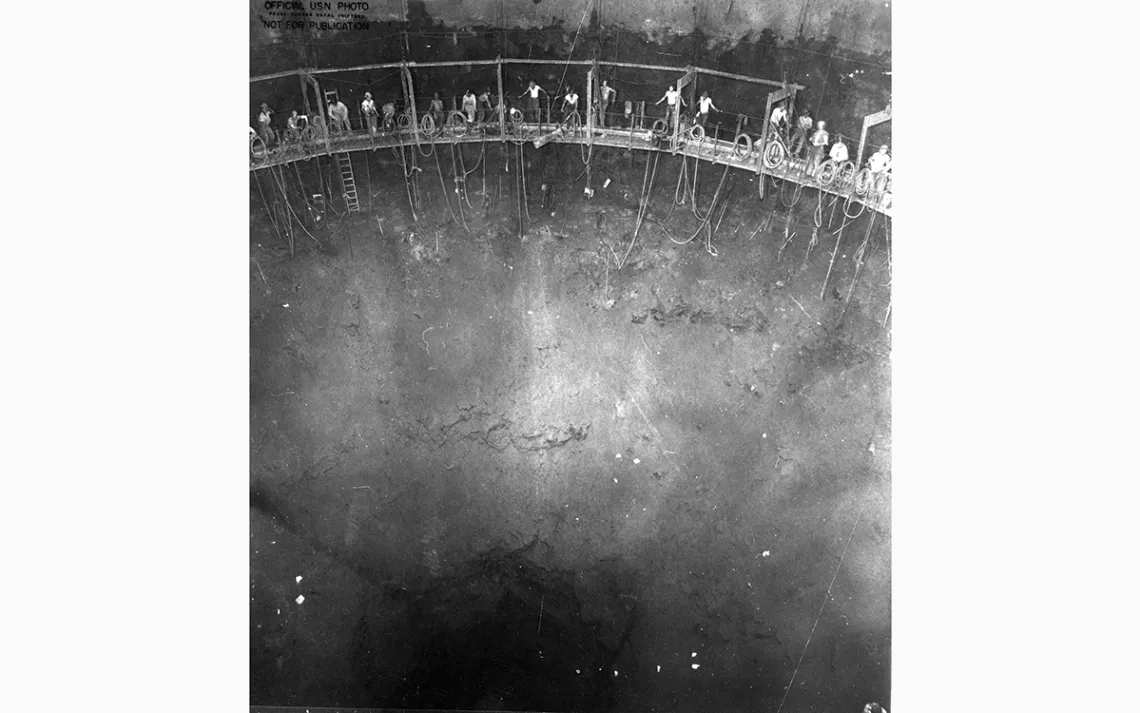Jet Fuel in Paradise
This is how you hobble a city’s climate resilience

Mobile Diving Salvage Unit One performs an inspection and sampling of a water well near Pearl Harbor, Hawai'i. | Photo by US Navy, Mass Communications Specialist 2nd Class Aja Bleu, Jackson via AP Photo
On December 2, Xavier Bonilla’s 17-year-old son called him from work, panicking because he couldn’t breathe. The symptoms had started after a shower, and by the time Bonilla reached his son, he was inside an ambulance, covered with a full-body rash and so swollen that Bonilla couldn’t see his eyes—"blown up like a balloon," Bonilla said. It took two EpiPens before his son was well enough to be released.
Others in the household got sick too. Some had headaches and brain fog. One ended up in the emergency room three or four times in December: itchy, dizzy, vomiting. The dog got sick. Bonilla’s son broke out in a rash every time he touched the water. Bonilla called building management and asked if anyone had reported problems. He was told that nobody else had complained about anything. But other neighbors said differently.
Sometime in December, the US Navy began bringing them water, Bonilla said. They began living on water from jugs, eating from paper plates, mastering the art of washing hands one-handed, bathing in a camp shower that a TikTokker rallied people online to buy them.
*

Miners building one of Red Hill's 20 fuel storage tanks in 1942 | Photo by US Army Corps of Engineers
Residents of Joint Base Pearl Harbor–Hickam, next to where Bonilla lived in Honolulu, had begun reporting that their navy-supplied tap water smelled like gasoline back in November. By early December, thousands of people were sickened and many hospitalized. The navy, whose water system serves 93,000 people, relocated thousands of military families to hotels and left civilians who were on the same water system, like Bonilla, to live on bottled water.
The culprit was a leaking pipeline from the navy’s Red Hill Underground Fuel Storage Facility—20 corroding underground tanks built in World War II with a 250-million-gallon total capacity. Tanks like these could never be built today—they’re just 100 feet above the aquifer that supplies almost all of O'ahu with drinking water. An estimated 19,000 gallons leaked, and now at least part of the aquifer was also supplying some people with jet fuel.
This wasn’t the first time. The Red Hill site, according to a state legal filing, has released fuel at least 73 times since 2014, totaling at least 173,000 gallons. On December 6, Hawai'i’s Department of Health ordered the navy to drain the tanks. The navy at first refused. On Monday, the Pentagon—after an onslaught of protests and political pressure—announced that Red Hill would be decommissioned, estimating it would take a year to drain the fuel.
*
So far, the leak has done more than create chaos and misery for several thousand people. It’s also significantly set back Honolulu’s climate change and disaster preparedness.
“This is a perfect example of compounding disasters that are both climate-related and non-climate-related,” said Victoria Keener, a climate scientist who lead-authored the 2018 National Climate Assessment for Hawai'i and the Pacific Islands and researches how global climate models work at local and regional scales, especially regarding freshwater resources.
Keener started filling up five-gallon jugs of water as soon as she heard about the leak. It felt crazy, she said, but she knew “things could have gotten really bad, really quickly.”
That Honolulu’s residents have groundwater at all is due to some lucky geology. Rainwater falls on the volcanic mountains and filters down slowly through all the little lava pores to arrive at the aquifer nice and clean. The aquifer is a freshwater lens, a bubble of water that floats on top of the ocean’s saltwater because freshwater is less dense than salt.
Climate change is threatening this aquifer from all sides, literally. Rainfall has decreased over the past century. O'ahu is in a severe drought; the period since 2008 is its driest on record. The island is seeing more extreme rain events, in which water runs out to the sea instead of trickling down to be useful.
Between the freshwater bubble and the salt is a brackish transition zone. Sea level rise is narrowing the freshwater lens, increasing the brackish zone below just as less water recharges it from above. Over-pump the aquifer and that could pull in saltwater and ruin it for everybody.
Adding jet fuel also ruins it for everybody. Before the leak, contentious questions had already come up about whether some wells were being pumped beyond what is sustainable. Now it’s vital to learn which way the fuel will go, and how pumping will affect that.
It’s hard enough to figure out which way water flows in a big aquifer, and the plume of leaked jet fuel is a mixture of stuff that sinks or flows at different rates. The navy produced one groundwater flow model, suggesting water from Red Hill won’t head toward city supplies. Other agencies aren’t buying it. A US Geological Survey model suggests the opposite. It could take years to understand the plume’s full extent.
*
The Board of Water Supply, which supplies O'ahu’s drinking water, wasn’t taking any chances. As soon as it found out about the November leak, the agency followed the plan it had for just this sort of contingency and hastily shut down its nearby Halawa shaft and two other wells to keep them from sucking fuel toward them through the aquifer.
The Halawa shaft normally provides 20 percent of Honolulu’s drinking water, so shutting it down “is analogous to an immediate drought,” according to a state water commission report published in February—just as the islands are heading into dry season. The shaft is also a key source of water in emergency plans, because it has a backup generator, so it can still supply water when the electrical grid goes out. According to the water commission, Honolulu is “likely to have a longer-term emergency water shortage” because of Red Hill.
Adding to O'ahu’s worries are the fact that hurricanes are spawning farther north lately. Though science is far from certain about this, the northward march of the hurricane nursery could make them more likely to hit Hawai'i. Hurricanes bring at least three kinds of water trouble: High waves could infiltrate the freshwater lens with more saltwater, winds could knock out power and other infrastructure that pumps water to people around the island, and both could flush out contaminants sitting around in the soil, polluting freshwater supplies or nearshore reef ecosystems.
Climate risks can be divided into stressors and shocks, Keener said. Stressors are the long-term problems, like drought and poverty and poorly maintained infrastructure. Shocks are the cyclones and tsunamis that hit all of a sudden. What can really break a place is combining the two, and how that works is a focus of Keener’s research. Stressors reduce a community’s adaptive capacity, and the shock amplifies the negative effects. Think Hurricane Maria hitting the underfunded infrastructure of Puerto Rico, Keener said. That’s why she’s so worried about Red Hill.
“We've just gotten rid of a lot of our resiliency to supply water to the island in case of a shock event like a hurricane,” Keener said. “Combine that with drought and you have a double whammy.”
*
A water shortage could affect every aspect of life, from construction to tourism, and would hit the lowest-income people the hardest, said Wayne Tanaka, president of the Sierra Club’s Hawai'i Chapter, which sued the navy to decommission the Red Hill tanks. And if O'ahu’s drinking water gets contaminated, you can’t relocate everyone in the city, he said. “It really is a crisis of existential proportions right now.”
As of late February, Bonilla was still drinking bottled water, and he was tired. He worked a state job to pay the rent and Uber Eats for the rest. It had already been hard enough to find affordable housing in Honolulu, and Red Hill had put him over the edge. He decided to move back to the mainland.
“I don’t trust the water. I don’t trust the government. I don’t trust the navy,” he said. “You can’t live without water.”
 The Magazine of The Sierra Club
The Magazine of The Sierra Club



